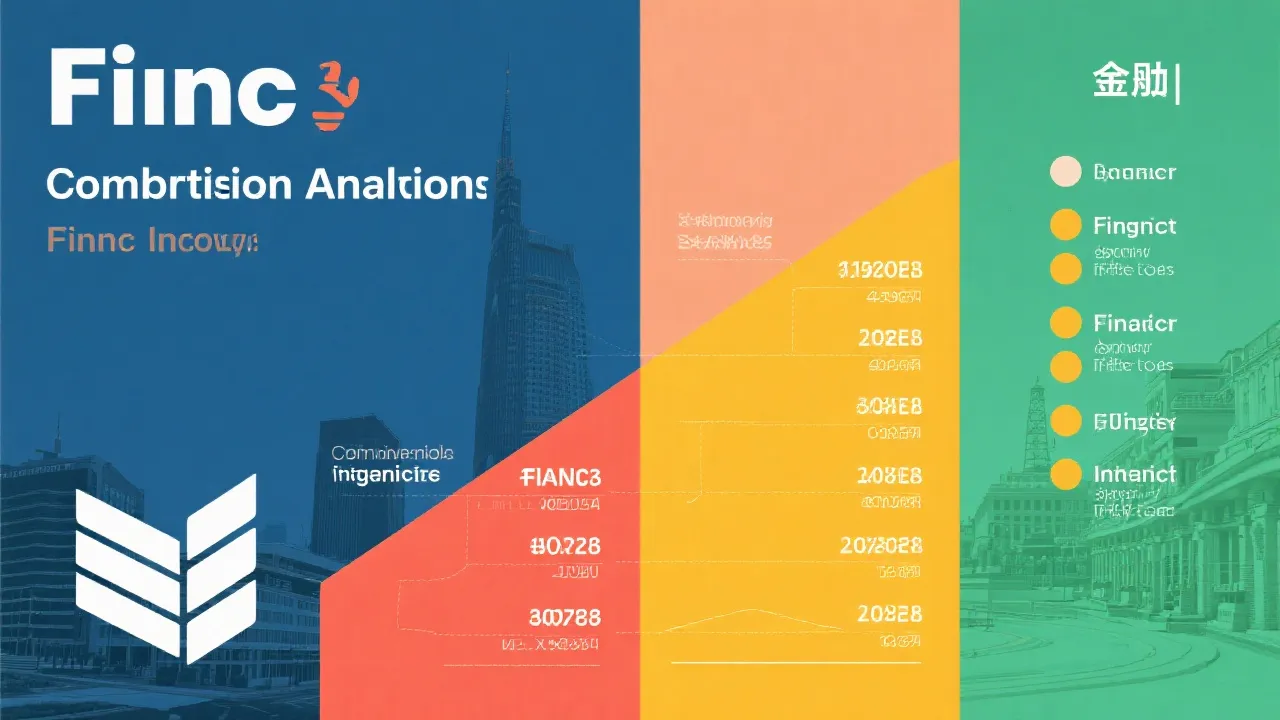Webbank stands as a significant entity in the financial sector, specializing in offering personal loans and various credit products. The competition in this space is intense, with numerous institutions aiming to deliver similar financial services but often catering to different market niches. This guide delves into the dynamics of Webbank's competitive environment, providing insights into strategic positioning among its peers.

Webbank, renowned for offering diverse financial solutions, competes vigorously in a sector characterized by rapid technological advancement and shifting customer expectations. As the financial landscape evolves, understanding Webbank's competitors is crucial for comprehending its strategic decisions and market influences. In this ever-changing environment, Webbank's ability to adapt and innovate will determine its position and success among both traditional and modern financial service providers. The rise of digital banking has led to increased competition, and Webbank aims to stand out through quality service and strategic positioning.
The realm of financial services is densely populated with players ranging from traditional brick-and-mortar banks to online-only entities, all vying for consumer trust and business. Understanding who these competitors are and what they offer can provide insight into Webbank's operational strategies and competitive advantages. In this section, we will explore key competitors that Webbank faces and analyze their strengths and weaknesses.
Established banks, such as JPMorgan Chase, Wells Fargo, and Bank of America, represent a significant portion of Webbank’s competition. These banks have extensive branch networks and offer comprehensive services beyond the digital scope, allowing them to maintain a strong physical presence. Many customers still value face-to-face interactions and the assurance that comes from dealing with long-standing institutions. This can be critical for clients requiring complex financial products, personal loans, or detailed investment services.
Moreover, these institutions possess a substantial resource base, allowing them to invest heavily in technology and marketing. They often have the ability to offer lower interest rates on loans due to their access to cheaper capital through deposits. However, their size can also make them sluggish in adopting trends and innovations, presenting an opportunity for agile firms like Webbank to capture niche markets.
Online platforms like LendingClub and Prosper provide peer-to-peer lending services, presenting a different model compared to traditional banks. They emphasize user-friendly online interfaces and appeal to tech-savvy borrowers seeking competitive rates. These platforms have revolutionized borrowing by connecting individuals willing to lend money with those seeking loans, bypassing traditional banking intermediaries.
This model allows for lower fees and faster processing times, but it also comes with risks. The reliance on technology necessitates robust cybersecurity measures to protect users, as well as effective credit assessment methods to ensure loan repayment reliability. While peer-to-peer lending platforms have carved out a significant niche, Webbank’s offerings can compete effectively by leveraging its own technology-driven approach while maintaining the reliability and reputation associated with traditional banking.
FinTech companies, including SoFi, Avant, and others, are gaining traction by offering innovative financial products and services with reduced overhead costs. These firms prove nimble and responsive, placing pressure on Webbank and others to adapt swiftly. Many FinTech companies focus on specific segments, such as personal finance management, investment services, or lending, allowing them to concentrate their resources and excel quickly in particular areas.
While some FinTechs have established a loyal customer base due to their innovative approaches and enhanced user interfaces, they sometimes lack the comprehensive service offerings that traditional banks provide. Webbank, therefore, must continually assess its competitive positioning and seek ways to integrate the best practices emerging from the FinTech sector into its own offerings.
| Competitor | Strengths | Weaknesses |
|---|---|---|
| JPMorgan Chase | Brand reputation, extensive branch network, diverse services | High fee structures, slower innovation adaptation |
| LendingClub | Lower fees, streamlined online processes | Limited physical presence, dependency on online platforms |
| SoFi | Innovative products, strong digital presence | Niche market focus, increasing competition |
This comparative analysis highlights the key strengths and weaknesses for each of the major competitors in the market. While JPMorgan Chase leverages its longstanding reputation and extensive service offerings, it faces criticism for high fees and a general lack of agility in adapting to changes in customer demand. In contrast, LendingClub and SoFi have cultivated positive reputations in the digital space but find themselves with limited physical presence and reliance on technology, which may alienate segments of the customer base that prefer traditional banking interactions.
Webbank's strategic approach involves leveraging its digital prowess to offer personalized services while ensuring competitive pricing. Its emphasis on technology-driven solutions helps mitigate challenges posed by both large traditional banks and agile FinTech firms. By positioning itself between these polar ends, Webbank can attract a broad customer base that seeks both reliability and innovative financial products.
Investing in technology is central to Webbank's strategy to improve the customer experience and operational efficiency. This involves the use of data analytics to tailor products and offerings that align with consumer needs. Moreover, the integration of artificial intelligence (AI) and machine learning within its operational framework allows Webbank to offer predictive analytics to anticipate customer behavior and optimize product recommendations.
Furthermore, embracing automation in customer service, such as chatbots and automated personal assistants, helps in reducing costs while enhancing customer satisfaction by providing instant responses to inquiries. Such technological advancements not only streamline operational processes but also foster an environment of continuous improvement and innovation.
Webbank prioritizes enhancing customer interfaces and interactions, providing seamless, responsive service across digital platforms to foster loyalty and retention. A seamless customer experience involves ensuring that clients can access their accounts, complete transactions, and communicate with support easily across all devices. To achieve this, Webbank invests in user experience (UX) research and design, implementing customer feedback into upgrades and new features.
This user-centric design strategy extends to the mobile application and website, where a focus on intuitive navigation and accessibility features can significantly reduce customer frustration and enhance engagement. Continuous monitoring of user interaction data also equips Webbank with insights to refine its offerings over time and to introduce new features that meet evolving consumer expectations. Additionally, maintaining transparency in communications, such as notifying customers about any changes or additions to products promptly, is fundamental to building trust and loyalty.
The financial sector anticipates several trends influencing competitive dynamics, including increased regulatory scrutiny, evolving customer expectations, and continuous technological innovation. Webbank's understanding of these trends can guide its strategic decisions and ensure it stays ahead in the competitive landscape.
Global and local regulations shape operational strategies, impacting how banks like Webbank manage compliance while pursuing growth. Regulatory frameworks are becoming more stringent, and navigating them effectively can pose challenges, especially for online banks that may not have a long history in compliance practices. New regulations related to data protection (like GDPR) and anti-money laundering (AML) require robust compliance mechanisms and can significantly affect operational costs.
However, regulatory changes can also create new avenues for growth. For instance, as regulations increase transparency requirements, Webbank can position itself as a more consumer-friendly alternative to traditional banks by proactively communicating its practices and products' benefits. This proactive compliance approach can help establish a solid reputation among consumers, which is critical in an industry often marred by distrust.
Emerging technologies such as blockchain, artificial intelligence, and cybersecurity enhancements will likely play pivotal roles in shaping the future of banking competition. Blockchain technology, for instance, promises to revolutionize transaction processing by providing secure, transparent, and tamper-proof transaction records. This could streamline processes such as international remittances and smart contracts, potentially positioning Webbank as an innovator within its market niche.
Moreover, advancements in cybersecurity technology are essential for maintaining consumer trust. With increasing instances of online fraud and data breaches, Webbank must dedicate resources to ensuring robust security measures are in place to protect sensitive customer information. Implementing advanced encryption techniques and multi-factor authentication is critical in safeguarding client accounts, thus solidifying Webbank's reputation as a secure banking option.
A key to Webbank's success lies in its ability to differentiate itself from competitors. This differentiation must resonate with consumers and highlight Webbank's unique service offerings. The following strategies can be employed to set Webbank apart:
Offering tailored financial products based on customer preferences and behaviors can significantly enhance customer satisfaction. By using data analytics to understand customer needs, Webbank can develop products that address specific issues, such as adjustable loan packages for borrowers with fluctuating incomes or specialized savings accounts targeting certain demographics.
This approach not only provides direct consumer benefits but also creates a competitive edge in a market saturated with one-size-fits-all products. Regularly updating and diversifying offerings based on consumer feedback and market trends can further enhance this strategy.
Webbank can position itself as a thought leader in the financial space by providing educational resources that empower consumers to manage their finances better. Offering webinars, informative blogs, and interactive tools on topics such as budgeting, investing, and credit management can build trust and loyalty among clients.
Additionally, extending these resources to underserved communities can facilitate brand loyalty from individuals who may traditionally lack access to robust financial education. Such initiatives not only align with Webbank’s corporate social responsibility goals but can also expand its customer base over time.
In an age where consumers are increasingly conscious of their choices, Webbank can differentiate itself by integrating sustainability into its core practices. This could include offering green loans for eco-friendly projects or investing in sustainable businesses. Communicating a commitment to environmentally responsible practices can attract a demographic focused on ethical banking.
Furthermore, aligning with sustainability can enhance Webbank's reputation among investors and partners, fostering long-term growth opportunities within increasingly competitive markets.
In conclusion, the competitive landscape of financial services, in which Webbank is an active participant, is complex and dynamic. By understanding the strengths and strategies of its competitors, Webbank can continue to refine its approach and maintain its position within the industry. The focus on technology, customer experience, regulatory compliance, and evolving market trends will be paramount for Webbank as it navigates the future of banking. As Webbank evolves, continuous assessment of its strategic position and adaptive tactics will be necessary for maintaining competitiveness and driving growth in an ever-evolving market landscape.
Understanding Sme Neobank Impact

Exploring Webbank and Its Competitors

Discover Westminster Plaza Orlando

Discover Heartis Eagle Mountain Elegance

Westminster Plaza Orlando: A Comprehensive Guide

Transforming Banking with Sme Neobank

Discovering Westminster Plaza Orlando

Discovering Westminster Plaza Orlando

Life Insurance for Seniors: Maximizing Coverage and Benefits
